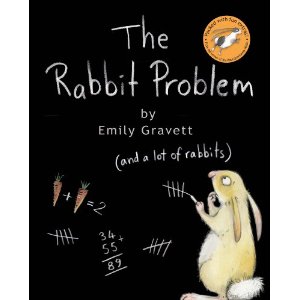 The Rabbit Problem, by Emily Gravett is not a traditional picture book (in a good way.) Set up like a calendar (complete with a hole for hanging), the story starts with one Lonely Rabbit in a field sending out invitations in January to find a friend. When Chalk Rabbit shows up in February, the two bundle together (in a poorly knit sweater) and in March, Alfalfa and Angora Rabbit show up…can you see where we are going with this? As each month passes, the Rabbit family grows and faces new challenges- dealing with the weather, finding food, findng things to do when they are bored and more. Will they make it through the year in their little field?
The Rabbit Problem, by Emily Gravett is not a traditional picture book (in a good way.) Set up like a calendar (complete with a hole for hanging), the story starts with one Lonely Rabbit in a field sending out invitations in January to find a friend. When Chalk Rabbit shows up in February, the two bundle together (in a poorly knit sweater) and in March, Alfalfa and Angora Rabbit show up…can you see where we are going with this? As each month passes, the Rabbit family grows and faces new challenges- dealing with the weather, finding food, findng things to do when they are bored and more. Will they make it through the year in their little field?
Instead of a traditional narrative/illustration format, Gravett uses illustrations, notes on the calendar, and add-ins like a knitting pattern, ration books, seed packets, newsletters, recipes and more in pockets, pop outs, and more interactive story-telling devices. The story unfolds naturally from these devices, the traditional narrative isn’t needed. You can spend so much time with this book just looking at the exquisite amount of detail, from funny notes on the calendar (Ways to Stay Warm: Knit Jumper, Hop, Think Warm Thoughts), to the cute and detail-packed illustrations (look for an ever-changing Field Population sign), fold outs, pockets and more.
Even though this book is based on Fibonacci’s sequence (in which each number is the sum of the 2 before it (0, 1, 1, 2, 3, 5, 8, 13 etc)) and the Rabbit Problem (If you start with 2 rabbits multiplying at a rate of 2 offspring per month how many will you have in a year?), it is not strictly a picture book to teach numbers. It may be based on a mathematical concept, but it is abundantly approachable and easy to understand. The Rabbit Problem could be used to teach so many different concepts-from the months of the year and weather during the seasons to growing families and working together. Of course, it also beautifully illustrates Fibonacci’s Rabbit Problem, but the abundance of cute rabbits (and rabbit-antics) make it so that anyone can enjoy this book, math friends and foes alike.
- Posted by Erin
